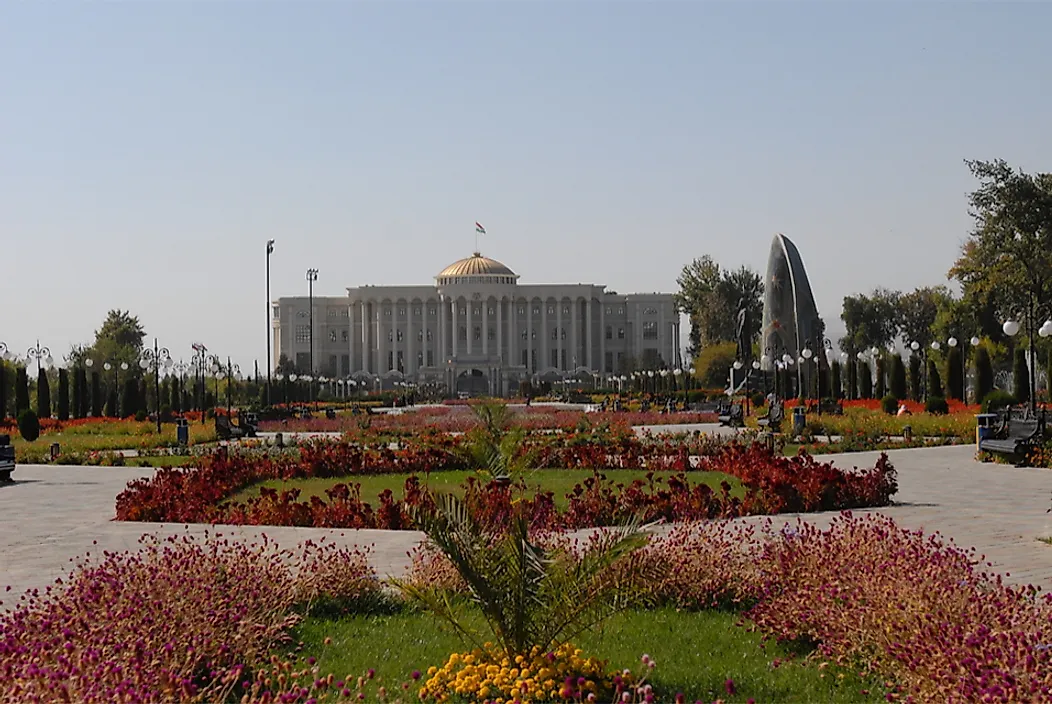Which Countries Border Tajikistan?

Tajikistan is a nation located in Central Asia. The country covers a total area of 55,300 square miles, making it the smallest in Central Asia in terms of area. It has a population size of over 8.73 million, the vast majority of whom identify as ethnic Tajik and speak the Tajik language (which is considered a dialect of the Persian language). The second most widely spoken language in the country is Russian, which has remained from the Soviet-era, when Tajikistan was part of the Soviet Union.
The landscape of Tajikistan is characterized by mountainous terrain, which is estimated to cover around 90% of the country. Given this abundance of mountains, more than half of Tajikistan is situated at an elevation greater than 9,800 feet above sea level. Other geographic landscapes include the Vakhsh and Kofarnihon river valleys and the Fergana Valley. Politically, Tajikistan is divided into four provinces.
Tajikistan is considered a landlocked country due to a lack of direct access to the open ocean. This position puts Tajikistan at a distinct disadvantage, particularly in terms of international trade, as it must rely on the surrounding countries for access to ports. Tajikistan shares its borders with four autonomous countries: China, Afghanistan, Uzbekistan, and Kyrgyzstan.
What Countries Border Tajikistan?
China
The border between China and Tajikistan runs for approximately 257.24 miles along the eastern edge of Tajikistan, separating the country from China's Xinjiang Province. The border runs in a north-south direction. At the northern end is a three-way border between Tajikistan, China, and Kyrgyzstan. At the southern end is another three-way border between Afghanistan, China, and Tajikistan. These two countries are only connected by one crossing, which is located at Kulma Pass in the Pamir Mountain range. This pass is situated at an elevation of 14,313 feet above sea level, runs from the north to the southeast, and is only about one-third of a mile wide and just over half of a mile in length. The Kulma Pass is only open to traffic for the last half of the month (from the 16th to the 30th) during 7 months of the year (May through November).
Afghanistan
Tajikistan shares a border with Afghanistan that runs for 810 miles. The Amu Darya River, which has a total length of 1,653 miles, makes up a portion of this border. Another section of the border between the two countries is marked by the Panj River, a tributary of the Amu Darya River. The Panj River is crossed by the Tajikistan-Afghanistan Friendship Bridge, which runs for a total length of 2,205 feet. The construction of the bridge was paid for by the US Army Corp of Engineers, and its inauguration occurred in 2007. The area surrounding the border is known to have rough terrain, which is both difficult and dangerous to cross. Additionally, the terrain makes it difficult for local authorities to patrol. The lack of law enforcement officials in this area has made it one of the most popular crossing points for drug smugglers in Central Asia.
Uzbekistan
The border between Uzbekistan and Tajikistan runs for approximately 797.21 miles along the western edge of Tajikistan. The two countries share a long history and between 1924 and 1929, Tajikistan (as an Autonomous Soviet Socialist Republic) was actually considered part of Uzbekistan. Today, a large number of ethnic Tajiks continue to live in Uzbekistan. Despite this shared history, the two countries have had a strained political relationship for decades. Recently, this relationship appears to be improving. For example, beginning in the 1990s, the 16 border crossings between Uzbekistan and Tajikistan were closed, preventing travel between the two countries. At the beginning of 2018, however, ten of these border crossing were reopened in a move aimed at promoting travel and trade between the two countries. This long border is also protected by numerous landmines that were placed by the government of Uzbekistan, making large stretches of territory between these two countries life-threatening to residents and travelers. The government of Uzbekistan has attempted to justify this action by claiming that the landmines are meant to prevent drug smuggling and terrorist activity. Many of the mine locations have been left unlabeled, which has resulted in several deaths and injuries. Some sections of this border have been disputed since the dissolution of the Soviet Union.
Kyrgyzstan
The border between Tajikistan and Kyrgyzstan is located along the northern edge of Tajikistan. Disputes between the two countries have resulted in an inconsistent border length measurement. Some sources report that the border runs for 613 miles, while others cite the border length at only 602.7 miles. The political relationship between these two countries has been strained since the dissolution of the Soviet Union, and this tension is also held by ethnic groups in both nations. These issues are illustrated by the dangers that occur along the border. In fact, the border between Kyrgyzstan and Tajikistan is considered dangerous due to the presence and activity of terrorist groups, drug smugglers, and other rebel groups. Additionally, a number of other illegal goods, such as weapons, are transported between the two countries. Most reports of rebel or anti-government groups crossing the border are individuals making their way from Tajikistan into Kyrgyzstan. In response to this instability, part of the border was closed during the mid-1990s. Today, it is primarily the area surrounding the Fergana Valley that remains under dispute. This area is home to several ethnic groups, which makes drawing a political line a difficult task. As a result, the entire border between the two countries has yet to be defined. Despite their differences, the governments of Tajikistan and Kyrgyzstan do come together in the face of conflict and threats from the government and population of neighboring Uzbekistan. An example of this cooperation occurred during the 2010 South Kyrgyzstan ethnic clashes.











